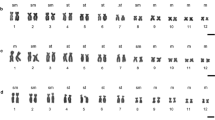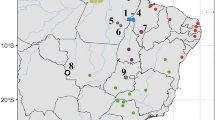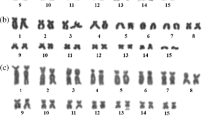Abstract
One of the first characteristics that we learn about the genome of many species is the number of chromosomes it is divided among. Despite this, many questions regarding the evolution of chromosome number remain unanswered. Testing hypotheses of chromosome number evolution using comparative approaches requires trait data to be readily accessible and associated with currently accepted taxonomy. The lack of accessible karyotype data that can be linked to phylogenies has limited the application of comparative approaches that could help us understand the evolution of genome structure. Furthermore, for taxonomists, the significance of new karyotype data can only be determined with reference to records for other species. Here, we describe a curated database (karyotype.org) developed to facilitate access to chromosome number and sex chromosome system data for amphibians. The open web interface for this database allows users to generate customized exploratory plots and tables of selected clades, as well as downloading CSV files for offline analyses.


Similar content being viewed by others
Abbreviations
- cf :
-
for the Latin conformis or conferre
- aff :
-
for the Latin affinis
References
Blackmon H, Demuth JP (2015) Genomic origins of insect sex chromosomes. Curr Opin Insect Sci 7:45–50
Blackmon H, Hardy NB, Ross L (2015) The evolutionary dynamics of haplodiploidy: genome architecture and haploid viability. Evolution 69:2971–2978
Blackmon H, Justison J, Mayrose I, Goldberg EE (2019) Meiotic drive shapes rates of karyotype evolution in mammals. Evolution 73:511–523
Chang, W., Cheng, J., Allaire, J., Xie, Y. & Mcpherson, J. 2018. Shiny: web application framework for R version 1.1.0
Charlesworth D, Charlesworth B (1980) Sex differences in fitness and selection for centric fusions between sex-chromosomes and autosomes. Genet Res 35:205–214
Fitzjohn RG (2012) Diversitree: comparative phylogenetic analyses of diversification in R. Methods Ecol Evol 3:1084–1092
Flemming, W. 1882. Zellsubstanz, kern und zelltheilung, Vogel
Freyman WA, Höhna S (2017) Cladogenetic and anagenetic models of chromosome number evolution: A Bayesian model averaging approach. Syst Biol 67:195–215
Frost DR (2018) Amphibian species of the world: an online reference. Version 6. 11 July 2018. American Museum of Natural History
Green DM, Sessions SK (1991) Amphibian cytogenetics and evolution. Academic Press, San Diego
Gregory TR (2001) The bigger the C-value, the larger the cell: genome size and red blood cell size in vertebrates. Blood Cell Mol Dis 27:830–843
Hillis DM (1991) The phylogeny of amphibians: current knowledge and the role of cytogenetics. Amphibian Cytogenet Evol:7–31
Kezer J (1964) Meiosis in salamander spermatocytes. The meehanics of inheritance. Found Mod Genetics Series 100
King M (1990) Animal cytogenetics: Amphibia. Gebruder Borntraeger, Berlin
Kitano J, Ross JA, Mori S, Kume M, Jones FC, Chan YF, Absher DM, Grimwood J, Schmutz J, Myers RM (2009) A role for a neo-sex chromosome in stickleback speciation. Nature 461:1079–1083
Lande R (1985) The fixation of chromosomal rearrangements in a subdivided population with local extinction and colonization. Heredity 54:323–332
Liedtke HC, Gower DJ, Wilkinson M, Gomez-Mestre I (2018) Macroevolutionary shift in the size of amphibian genomes and the role of life history and climate. In: Nature Ecology & Evolution
Mohlhenrich ER, Mueller RL (2016) Genetic drift and mutational hazard in the evolution of salamander genomic gigantism. Evolution 70:2865–2878
Morescalchi A (1973) Amphibia. In: Cytotaxonomy and vertebrate evolution, pp 233–347
Paradis E, Blomberg S, Bolker B, Brown J, Claude J, Cuong HS, Desper R, Didier G (2018) Package ‘ape’. In: Analyses of phylogenetics and evolution, version, vol 2, pp 4–1
Pennell MW, Kirkpatrick M, Otto SP, Vamosi JC, Peichel CL, Valenzuela N, Kitano J (2015) Y fuse? Sex chromosome fusions in fishes and reptiles. PLoS Genet 11:e1005237
Rees JA, Cranston K (2017) Automated assembly of a reference taxonomy for phylogenetic data synthesis. Biodiversity Data J
Revell LJ (2012) Phytools: an R package for phylogenetic comparative biology (and other things). Methods Ecol Evol 3:217–223
Ross L, Blackmon H, Lorite P, Gokhman V, Hardy N (2015) Recombination, chromosome number and eusociality in the hymenoptera. J Evol Biol 28:105–116
Roth G, Blanke J, Wake DB (1994) Cell size predicts morphological complexity in the brains of frogs and salamanders. Proc Natl Acad Sci 91:4796–4800
Schmid M, Bogart J, Hedges S (2010) The chromosomes of terraranan frogs. Insights into vertebrate cytogenetics. Cytogenet Genome Res 130:1–568
Session AM, Uno Y, Kwon T, Chapman JA, Toyoda A, Takahashi S, Fukui A, Hikosaka A, Suzuki A, Kondo M (2016) Genome evolution in the allotetraploid frog Xenopus laevis. Nature 538:336–343
Sherman PW (1979) Insect chromosome numbers and Eusociality. Am Nat 113:925–935
Sun C, Shepard DB, Chong RA, López Arriaza J, Hall K, Castoe TA, Feschotte C, Pollock DD, Mueller RL (2011) LTR retrotransposons contribute to genomic gigantism in plethodontid salamanders. Genome Biol Evol 4:168–183
Sved JA, Chen Y, Shearman D, Frommer M, Gilchrist AS, Sherwin WB (2016) Extraordinary conservation of entire chromosomes in insects over long evolutionary periods. Evolution 70:229–234
Voss SR, Kump DK, Putta S, Pauly N, Reynolds A, Henry R, Basa S, Walker JA, Smith JJ (2011) Origin of amphibian and avian chromosomes by fission, fusion, and retention of ancestral chromosomes. Genome Res, gr 116491:110
White MJD (1977) Animal cytology & evolution. University Press, Cambridge
Zenil-Ferguson R, Burleigh JG, Ponciano JM (2018) Chromploid: an R package for chromosome number evolution across the plant tree of life. Appl Plant Sci 6:e1037
Author information
Authors and Affiliations
Contributions
HB and RHA conceived of the database and developed the ontology used. HB and RP both contributed to writing the manuscript, and collection of records. Research towards name resolution was performed by all authors and all authors edited the manuscript.
Corresponding author
Ethics declarations
Competing interests
The authors declare no conflict of interest.
Additional information
Responsible Editor: Beth A. Sullivan
Publisher’s note
Springer Nature remains neutral with regard to jurisdictional claims in published maps and institutional affiliations.
Rights and permissions
About this article
Cite this article
Perkins, R.D., Gamboa, J.R., Jonika, M.M. et al. A database of amphibian karyotypes. Chromosome Res 27, 313–319 (2019). https://doi.org/10.1007/s10577-019-09613-1
Received:
Revised:
Accepted:
Published:
Issue Date:
DOI: https://doi.org/10.1007/s10577-019-09613-1




